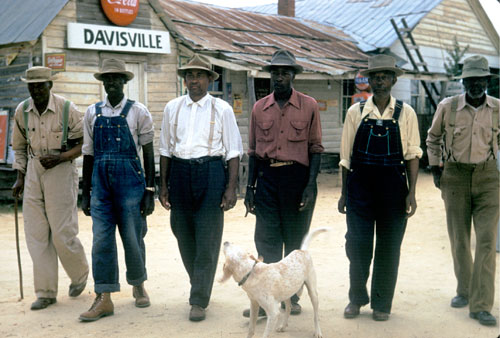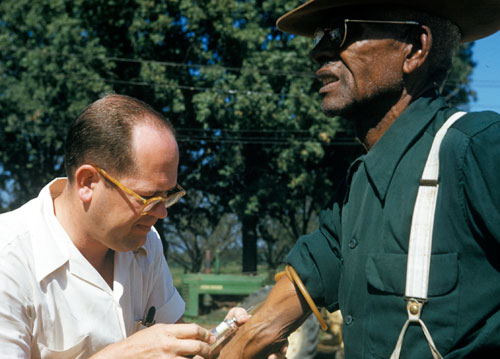Remembering Tuskegee
For many blacks, particularly those who grew up in the South and attended segregated schools and churches where black history week — and then later Black History Month — was a major event each year, the word “Tuskegee” evokes feelings of pride. It was in Tuskegee, Ala., that Booker T. Washington built a pillar of the black community, the Tuskegee Institute, which was founded to educate recently freed blacks in skills that would enable them to make a living. It was the Tuskegee Institute that lured the renowned black scientist George Washington Carver from Iowa State University to head its agricultural department, at which he did the majority of his acclaimed research. Tuskegee also evokes images of the famed all-black squadron of airmen -- the "Red Tails" -- who fought in World War II. However, despite the many prideful images that it brings to mind, the name “Tuskegee” is also a sobering reminder of racism and classism in science, the unethical treatment of research subjects and the need to ensure that “informed consent” means that research subjects are thoroughly apprised of the risks and consequences associated with participating in a study.
 Tuskegee syphilis study subjects in Davisville, Ala., 1953.National Archives
Tuskegee syphilis study subjects in Davisville, Ala., 1953.National Archives
This month marks the 40th anniversary of the beginning of the end of one of the darkest periods in the history of American science. On July 26, 1972, an article written by Jean Heller of the Associated Press appeared on the front page of The New York Times and other major newspapers and shocked the moral fiber of this nation. The first sentence of the article read: “For 40 years the United States Public Health Service has conducted a study in which human beings with syphilis, who were induced to serve as guinea pigs, have gone without medical treatment for the disease and a few have died of its late effects, even though an effective therapy was eventually discovered.” (Click here to read the entire article.) The article disclosed a 40-year study conducted in large part by the U.S. Public Health Service. This study, formally called the “Tuskegee Study of Untreated Syphilis in the Negro Male,” followed the progression of untreated syphilis in black men in Macon County — of which Tuskegee is the county seat — from 1932 until 1972 and was halted primarily because of ensuing public outrage over the kind of treatment of people that evoked memories of atrocities in Nazi Germany.
 Photo of Tuskegee study subject having blood drawn.National ArchivesBecause of rampant racism at the time and the fact that many of these black participants were poor, uneducated, hungry and destitute, they were deftly taken advantage of for 40 years, standing little chance against the combined efforts of the U.S. PHS; state, county and local health services in Alabama; officials at Tuskegee University; the National Institutes of Health; the Centers of Disease Control; and, among others, several U.S. surgeon generals who were aware of the study. The PHS not only refused them treatment for syphilis, it also discouraged others from treating them. This tragic American story, now a classic in the emerging field of bioethics, is vividly told in a least three well-known books: “Bad Blood,” by James H. Jones; “Examining Tuskegee: The Infamous Syphilis Study and Its Legacy,” by Susan Reverby; and “The Tuskegee Syphilis Study,” by Fred Gray.
Photo of Tuskegee study subject having blood drawn.National ArchivesBecause of rampant racism at the time and the fact that many of these black participants were poor, uneducated, hungry and destitute, they were deftly taken advantage of for 40 years, standing little chance against the combined efforts of the U.S. PHS; state, county and local health services in Alabama; officials at Tuskegee University; the National Institutes of Health; the Centers of Disease Control; and, among others, several U.S. surgeon generals who were aware of the study. The PHS not only refused them treatment for syphilis, it also discouraged others from treating them. This tragic American story, now a classic in the emerging field of bioethics, is vividly told in a least three well-known books: “Bad Blood,” by James H. Jones; “Examining Tuskegee: The Infamous Syphilis Study and Its Legacy,” by Susan Reverby; and “The Tuskegee Syphilis Study,” by Fred Gray.
Before the age of modern antibiotics, syphilis was a devastating disease that swept through Europe, the Americas and other parts of the world as early as the 16th century and was thought to be spread by invading armies during wartime and colonialism. Because the best means of transmission of the bacterium responsible for the disease, Treponema palladium, is by sexual intercourse, it also carried — and still does — negative social connotations. At the turn of the century, significant international research efforts were focused on understanding the etiology and consequences of the disease, which exists in four stages of infection: primary, secondary, latent and tertiary. During the primary stage, in which infection is now easily cured by a single dose of penicillin, the infection is most contagious. As it passes through later stages, it becomes less infectious but more difficult to cure. At the tertiary stage, although no visible signatures of the disease are usually present, it can begin to attack vital organs, leading to blindness, cardiovascular disease and neurological decline. In the early 20th century, before penicillin had emerged as an effective treatment, the early stages of the disease typically were treated with various combinations of heavy metals, including mercury-based compounds and arsenicals, among others, with variable results. Not everyone infected became seriously ill, and heavy metal treatment, especially in the later stages of infection, often was believed to be worse than the disease itself.
Between 1891 and 1910, a pivotal study was conducted in Oslo, Norway, in which 2,000 patients with primary and secondary syphilis were hospitalized until their lesions healed. They were not treated for the disease, because it was believed that the body’s own defense mechanisms could combat it better than the treatments at that time. This study was halted in 1910, however, when arsenic therapy for the disease was discovered. Later follow-up of some of the patients detailed the number of whom exhibited signs of heart disease and neurological complications.
During this time, which coincided with the rise of eugenics theory, there was a prevailing notion that the progression of the disease varied between racial groups. The finding from an earlier U.S. PHS study supported by the Rosenwald Fund, which indicated that the incidence of syphilis in blacks in Macon County, Ga., approached 40 percent, suggested to PHS officials an unprecedented opportunity to study the effects of untreated syphilis and to ascertain whether the disease progressed differently in blacks than whites. PHS officials enlisted the services of a very dedicated black nurse to help recruit about 600 participants, 399 of whom were serologically positive and 201 of whom served as controls.
 Photo of Tuskegee study subjectNational ArchivesThese individuals were not explicitly told they had syphilis but rather that they were being treated for “bad blood,” which was an ambiguous term for a number of ailments at that time within the black community. To entice them to participate, the men were given routine physical exams and free treatments for other minor ailments, burial stipends and, for some, minor financial compensation in the amount of $1 for every year one participated in the study. In exchange, participants provided consent for their bodies to be autopsied at the time of their deaths. They were never treated for their “bad blood” but instead were unknowingly given placebos. Sadly, the absence of treatment persisted beyond the mid-1940s, when penicillin became generally available in the U.S. for this medical indication. In fact, PHS officials believed that the most rigorous analysis of the progression of the disease could be brought about only by autopsy; therefore, from a scientific perspective, it was not in researchers' best interests to try to cure these men. As excuses, PHS officials rationalized that these individuals never would have received treatment anyway and also suggested that administration of the drug to individuals in late stages of the disease could do more harm than good.
Photo of Tuskegee study subjectNational ArchivesThese individuals were not explicitly told they had syphilis but rather that they were being treated for “bad blood,” which was an ambiguous term for a number of ailments at that time within the black community. To entice them to participate, the men were given routine physical exams and free treatments for other minor ailments, burial stipends and, for some, minor financial compensation in the amount of $1 for every year one participated in the study. In exchange, participants provided consent for their bodies to be autopsied at the time of their deaths. They were never treated for their “bad blood” but instead were unknowingly given placebos. Sadly, the absence of treatment persisted beyond the mid-1940s, when penicillin became generally available in the U.S. for this medical indication. In fact, PHS officials believed that the most rigorous analysis of the progression of the disease could be brought about only by autopsy; therefore, from a scientific perspective, it was not in researchers' best interests to try to cure these men. As excuses, PHS officials rationalized that these individuals never would have received treatment anyway and also suggested that administration of the drug to individuals in late stages of the disease could do more harm than good.
One of the myths related to the study is that PHS officials purposely infected black men in Macon County, Ala., with syphilis; however, there is no credible evidence to support this theory. Shockingly, while researching her book on the Tuskegee study, Reverby uncovered evidence that PHS doctors did deliberately infect almost 700 Guatemalan soldiers, prison inmates and mentally ill patients with venereal diseases in a separate study between 1946 and 1948 to test the efficacy of penicillin as a treatment.
Scholars still argue about the degree of wrongdoing in the Tuskegee syphilis study, and many of the major players involved died without ever admitting, or perhaps even believing, they had done wrong. At the very least, the Tuskegee story is a tragic reminder that science is too powerful for any one racial or ethnic group not to be involved in scientific decision making at the highest levels of government, private industry and professional societies. Although collaboration with blacks was essential for a study of such magnitude to be conducted for such a long period of time, it could be argued that had a black PHS official of high rank who really understood the essence and consequences of what was transpiring been involved in decision making, someone would have uttered, at the very least, “I’m not sure this is a good idea.”
Enjoy reading ASBMB Today?
Become a member to receive the print edition monthly and the digital edition weekly.
Learn moreGet the latest from ASBMB Today
Enter your email address, and we’ll send you a weekly email with recent articles, interviews and more.
Latest in Opinions
Opinions highlights or most popular articles

A paleolithic peer review
You might think review panels have only been around for the last century or so. You would be mistaken.

Early COVID-19 research is riddled with poor methods and low-quality results
The pandemic worsened, but didn’t create, this problem for science.

So, you went to a conference. Now what?
Once you return to normal lab life, how can you make use of everything you learned?

My guitar companion
A scientist takes a musical journey through time and around the world.

Catalyzing change and redefining purpose
To mark Women’s History Month, Sudha Sharma writes about her journey from focusing on her own research program to being part of a collaborative COVID-19 project.

The power of sabbaticals
To mark Women’s History Month, Nicholas Rhind writes about learning techniques in other researchers’ labs that empower the work in his own.

